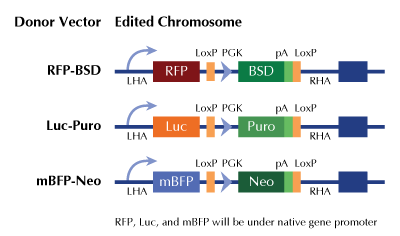TLR7 Human Gene Knockout Kit (CRISPR)
CAT#: KN207515BN
TLR7 - human gene knockout kit via CRISPR, HDR mediated
Functional Cassette: GFP-puro Luciferase-Puro RFP-BSD
HDR-mediated knockout kit validation
USD 1,657.00
4 Weeks*
Specifications
| Product Data | |
| Format | 2 gRNA vectors, 1 mBFP-Neo donor, 1 scramble control |
| Donor DNA | mBFP-Neo |
| Symbol | TLR7 |
| Locus ID | 51284 |
| Components |
KN207515G1, TLR7 gRNA vector 1 in pCas-Guide CRISPR vector KN207515G2, TLR7 gRNA vector 2 in pCas-Guide CRISPR vector KN207515BND, donor DNA containing left and right homologous arms and mBFP-Neo functional cassette. GE100003, scramble sequence in pCas-Guide vector |
| Disclaimer | These products are manufactured and supplied by OriGene under license from ERS. The kit is designed based on the best knowledge of CRISPR technology. The system has been functionally validated for knocking-in the cassette downstream the native promoter. The efficiency of the knock-out varies due to the nature of the biology and the complexity of the experimental process. |
| Reference Data | |
| RefSeq | NM_016562 |
| UniProt ID | Q9NYK1 |
| Synonyms | TLR7-like |
| Summary | The protein encoded by this gene is a member of the Toll-like receptor (TLR) family which plays a fundamental role in pathogen recognition and activation of innate immunity. TLRs are highly conserved from Drosophila to humans and share structural and functional similarities. The human TLR family comprises 11 members. They recognize pathogen-associated molecular patterns (PAMPs) that are expressed on infectious agents, and mediate the production of cytokines necessary for the development of effective immunity. For the recognition of structural components in foreign microorganisms, the various TLRs exhibit different patterns of expression as well; in this way for example, TLR-3, -7, and -8 are essential in the recognition of single-stranded RNA viruses. TLR7 senses single-stranded RNA oligonucleotides containing guanosine- and uridine-rich sequences from RNA viruses, a recognition occuring in the endosomes of plasmacytoid dendritic cells and B cells. This gene is predominantly expressed in lung, placenta, and spleen, and is phylogenetically related and lies in close proximity to another family member, TLR8, on chromosome X. [provided by RefSeq, Aug 2020] |
Documents
| Product Manuals |
| FAQs |
| SDS |
Resources
Other Versions
| SKU | Description | Size | Price |
|---|---|---|---|
| KN207515 | TLR7 - human gene knockout kit via CRISPR, HDR mediated |
USD 1,657.00 |
|
| KN207515LP | TLR7 - human gene knockout kit via CRISPR, HDR mediated |
USD 1,657.00 |
|
| KN207515RB | TLR7 - human gene knockout kit via CRISPR, HDR mediated |
USD 1,657.00 |
|
| KN407515 | TLR7 - KN2.0, Human gene knockout kit via CRISPR, non-homology mediated. |
USD 1,657.00 |
|
| GA109704 | TLR7 CRISPRa kit - CRISPR gene activation of human toll like receptor 7 |
USD 1,657.00 |
{0} Product Review(s)
Be the first one to submit a review






























































































































































































































































 Germany
Germany
 Japan
Japan
 United Kingdom
United Kingdom
 China
China
